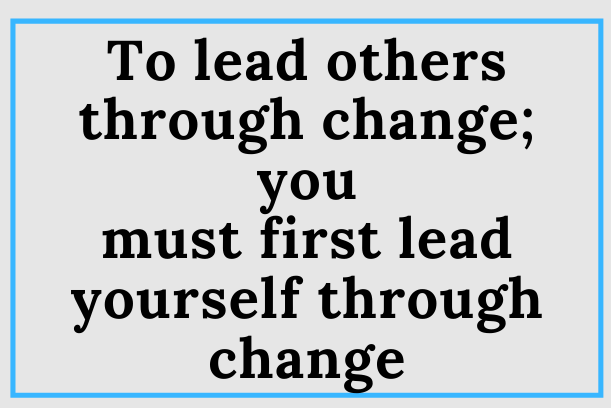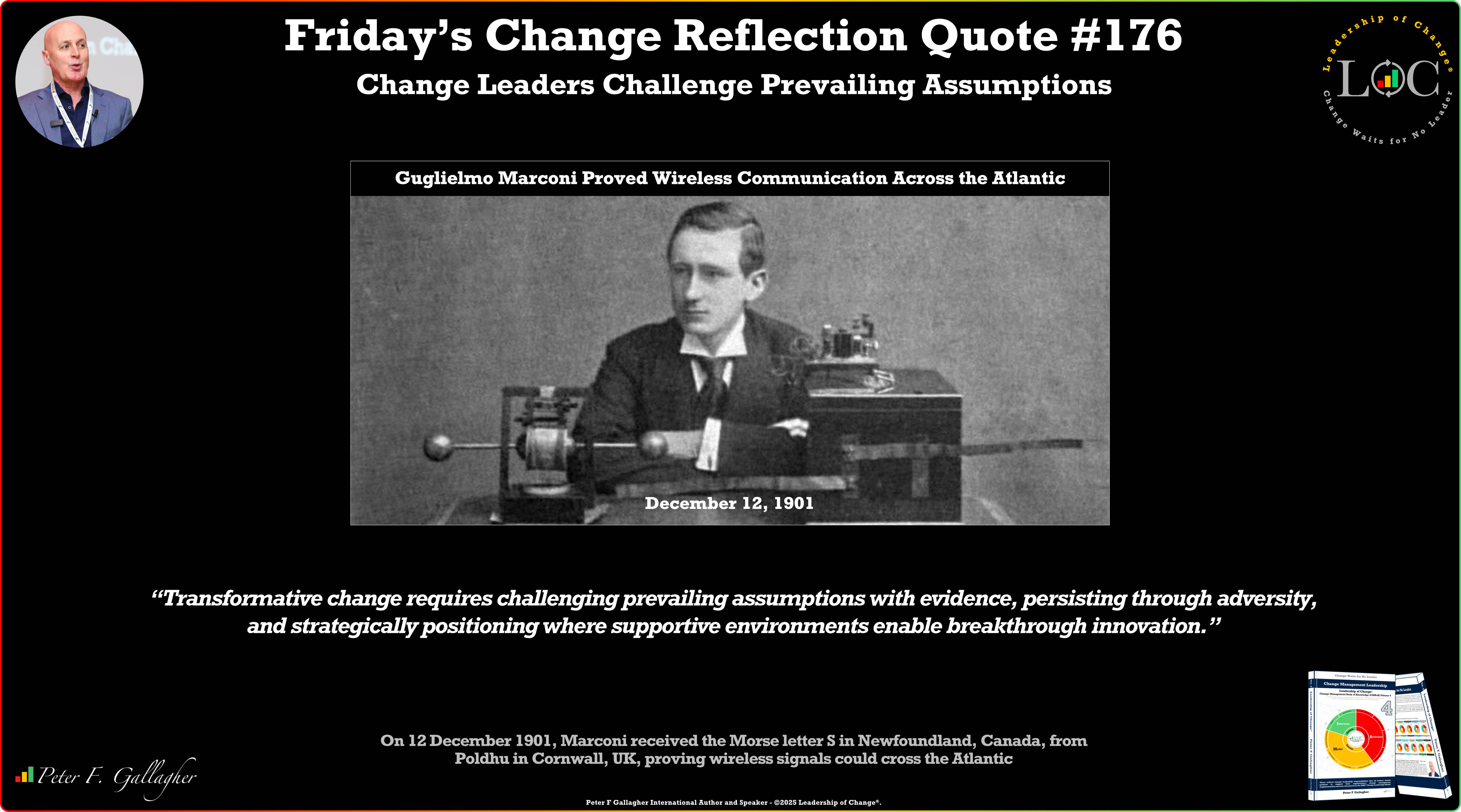Aug27

When you push people through change, it is a poor experience. Highly effective leaders treat change as an experience. They lead from the front, buy-in to the change first, and then lead their people through that change.
Over your career, and your time leading a team, would you say you have developed yourself to become a better leader? Have you developed yourself in the area of leadership and how to lead people (character)? Or, have you developed yourself in the area of management and how to manage people, processes and things (competency)?
Be honest with yourself when answering these questions. You are well aware now that we can only lead people, we cannot manage people.
The reason that most people in leadership positions prefer to manage people rather than lead people is because, management is easy, and leadership is difficult.
To lead others and to help them grow, you must first lead yourself, and work on yourself every day so that you grow. Be honest with yourself. Do you lead yourself, and work on yourself every day?
Have you accepted the responsibility to help develop each individual on your team in the area of leadership (character)? Do you take the easy way out and manage your people instead of lead them? Do you only develop them so they are able to do the job (competency)?
If you want to strive towards becoming a highly effective leader, then you need to embrace a new way of thinking. You must help yourself and your team to experience a new kind of change. By embracing a new way of thinking, it will be your role to help your people to embrace a new way of thinking too.
You must constantly be developing yours and your team’s minds. As you work on developing minds, you are freeing up space in the mind to also develop new, or continuously improving old processes. Experience a dramatic change in your team, and keep going.
From now on, if you want to implement a new idea, change, or process, you will need your team to buy-in to you and the idea, change, or process, and what the benefits are. To get your team’s buy-in, you need to inspire them and motivate them.
If you have been managing your team rather than leading them this is going to be a lot more difficult. You need to change your way of thinking first. You must lead yourself, and motivate yourself before you can motivate your team.

We have discussed how difficult it is to get a team to buy-in to a new change. As you are aware, most teams will resist new change because they are not bought in, and do not want to change. So make it as easy as possible for yourself. Only when you have bought-in to yourself and the new change, can you lead your team to do the same.
With me writing this article, my other articles, and creating my other materials, I am trying my best to inspire you and motivate you to buy-in to me. As you are reading this article, it is my role to help you release the potential you have to become a highly effective leader.
I want to set you down the right path on your journey to becoming a highly effective leader. When you release this potential, you can then help your people to do exactly the same as you, and set them on their journey to becoming highly effective leaders.
At this moment in time, does your team follow you because they want to (leadership), or do they follow you because they have to (management)? Again, be honest with yourself. If you want your team to buy-in to your idea, change, and your vision, then they must first buy-in to you.
If they buy-in to you first, then they are following you because they want to, and you are on the right path to actually becoming their leader. If they do not buy-in to you, then you unfortunately are not their leader. You are just someone who is filling the leadership vacancy.
It took me a number of years while being in my first couple of leadership positions to figure out why some of the changes I wanted to implement, did not work…They did not buy-in to me first.
I wasn’t working on myself every day, so I wasn’t leading myself first, and I wasn’t really buying-in to the change first. It felt almost like bringing in change, just so I could say I brought in change.
After I had spoken with my mentor, and he helped me to realise that I needed to get the team to buy-in to me first, I knew exactly what to do. I needed to change the environment. I needed to create an environment that encouraged continuous improvement for ourselves, not just our processes.
I needed to lead by example by working on myself, and then helping my team to work on themselves and develop. Only when I did that would the team buy-in to me, and eventually I could lead them through the change.
With this website and my articles, I am creating an environment to help you continuously improve yourself. I am not creating an environment to help you continuously improve your processes. Continuously improving yourself is a part of your personal growth, and is a personal growth principle.
When we focus on continuously improving our processes, we are expecting to improve our results. Now, we need to change how we think of continuously improving ourselves. We need to get comfortable, and believe in the process that when we continuously improve ourselves, we can also expect to improve our results.
A highly effective leader’s mission is to inspire their team, and motivate them to continuously improve. Make it your mission to do the same.
Low performing leaders focus solely on the results. They do not focus on the people at all, unless they want them to do a certain task. So they will arrange for them to learn the new task, but will not help their people to develop their character and leadership.
Low performing leaders don’t even focus on developing their own character and leadership either. All they are interested in is using their people to make themselves look good to the leaders of the organisation. I know this because I have been manipulated many times.

It is a horrible feeling when you know you are being manipulated. That’s how you can tell it is a manipulation because it is a feeling that you have that something isn’t right. But, I didn’t say or do anything about it because I didn’t want to upset my boss, or “rock the boat” in any way.
So, I just got on with it and let myself be manipulated. However, after a while I needed to snap out of it and think differently. I needed to believe in myself a lot more. I needed to lead myself better.
I needed to work on myself so I wouldn’t be manipulated again. I needed to become a highly effective leader, and have respect for myself and my people.
Highly effective leaders lead their people through their strong character, and they have integrity. No matter what kind of environment they are working in, they truly stand up for what they believe in. They will never let themselves, or their team be manipulated.
They will never manipulate anyone else either. Even if the senior leaders of the organisation are low performing leaders, a highly effective leader will not allow any kind of manipulation happen.
Most of the organisations I have worked with have had traditional leadership team setups. Their senior leaders focus on the results, not their people. The senior leaders do not have respect for their people because they don’t develop their people.
I tried my best to ensure that the team I led did have those opportunities to develop, and did not follow the norm. I know this because I respected my people, and we worked on ourselves, and developed ourselves every day.
When I lead a team, I do my best to make sure that they feel that I respect them. I do not want them to feel that I am being fake. When I know that my team feels that I respect them, I can also feel that they respect me.
When respect goes both ways, that is when I find it easy to help them develop themselves, and we can achieve great results together. Respect both ways is what highly effective leaders focus on and count on.
I welcome hearing how this post has influenced the way you think, the way you lead, or the results you have achieved because of what you’ve learned in it. Please feel free to share your thoughts with me by commenting below.
All the best,
By Tom Lawrence
Keywords: Culture, Leadership, Transformation
 The Agentic Superiority of Gemini 3 Pro: Scale, Multimodality, and Ecosystem Integration
The Agentic Superiority of Gemini 3 Pro: Scale, Multimodality, and Ecosystem Integration Data Isn’t the Problem. Alignment Is.
Data Isn’t the Problem. Alignment Is. Friday’s Change Reflection Quote - Leadership of Change - Change Leaders Challenge Prevailing Assumptions
Friday’s Change Reflection Quote - Leadership of Change - Change Leaders Challenge Prevailing Assumptions The Corix Partners Friday Reading List - December 12, 2025
The Corix Partners Friday Reading List - December 12, 2025 Measuring the True ROI of Automated Claims Processes: Beyond Speed and Cost
Measuring the True ROI of Automated Claims Processes: Beyond Speed and Cost